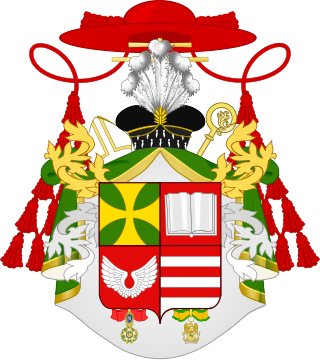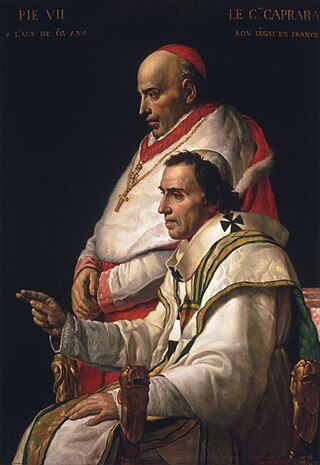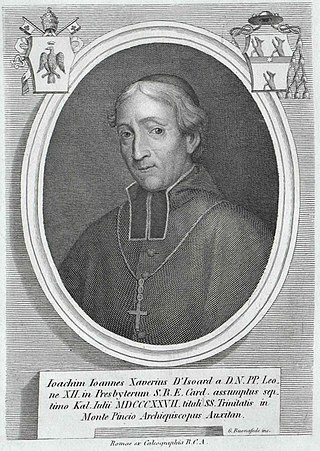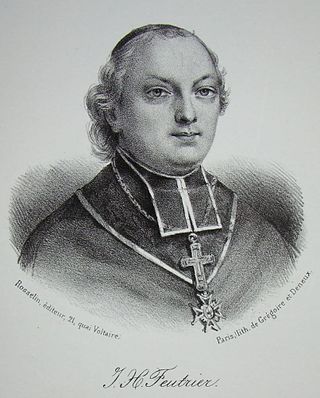
Joseph Cardinal Fesch, Prince of the Empire was a French priest and diplomat, who was the maternal half-uncle of Napoleon Bonaparte. In the wake of his nephew, he became Archbishop of Lyon and cardinal. He was also one of the most famous art collectors of his period, remembered for having established the Musée Fesch in Ajaccio, which remains one of the most important Napoleonic collections of art.

Jean-Sifrein Maury was a French cardinal, archbishop of Paris, and former bishop of Montefiascone.

Giovanni Battista Caprara Montecuccoli was an Italian statesman and cardinal and archbishop of Milan from 1802 to 1810. As a papal diplomat he served in the embassies in Cologne, Lausanne, and Vienna. As Legate of Pius VII in France, he implemented the Concordat of 1801, and negotiated with the Emperor Napoleon over the matter of appointments to the restored hierarchy in France. He crowned Napoleon as King of Italy in Milan in 1805.

Louis-Mathias, Count de Barral was a French church figure.

The Archdiocese of Lyon, formerly the Archdiocese of Lyon–Vienne–Embrun, is a Latin Church metropolitan archdiocese of the Catholic Church in France. The archbishops of Lyon are also called primates of Gaul. An archbishop is usually elevated by the pope to the rank of cardinal.

The Archdiocese of Aix-en-Provence and Arles is a Latin Church ecclesiastical territory or archdiocese of the Catholic Church in France. The archepiscopal see is located in the city of Aix-en-Provence. The diocese comprises the department of Bouches-du-Rhône, in the Region of Provence-Alpes-Côte d'Azur. It is currently a suffragan of the Archdiocese of Marseilles and consequently the archbishop no longer wears the pallium.

Jean-Baptiste Count de Belloy was an Archbishop of Paris and cardinal of the Catholic Church.

The Diocese of Nancy and Toul is a Latin Church ecclesiastical territory or diocese of the Catholic Church in France. After a considerable political struggle between Louis XV, Louis XVI, and the Dukes of Lorraine, the diocese was erected by Pope Pius VI on 17 December 1777. The Diocese of Nancy is a suffragan diocese in the ecclesiastical province of the metropolitan Archdiocese of Besançon.

Paul-Thérèse-David d'Astros was a French Roman Catholic Cardinal and archbishop.

The Archdiocese of Chambéry, Saint-Jean-de-Maurienne, and Tarentaise is a Latin Church archdiocese of the Catholic Church in France and a suffragan of the Archdiocese of Lyon. The archepiscopal see is Chambéry Cathedral, located in the city of Chambéry. The archdiocese encompasses the department of Savoie, in the Region of Rhône-Alpes.

Maurice-Jean Madeleine de Broglie was a French aristocrat and bishop. He was the son of Marshal of France Victor-Francois, Duc de Broglie, created, by Emperor Francis I, Prince of the Holy Roman Empire, a title which was to be hereditary in the family.

Louis Belmas was a French Catholic churchman and bishop.

The relationship between Napoleon and the Catholic Church was an important aspect of his rule.

Antoine-Éléonor-Léon Leclerc de Juigné was a French Catholic prelate and politician who served as Archbishop of Paris from 1782 to 1802. He was elected deputy of the clergy to the Estates General of 1789.

Étienne-Hubert de Cambacérès was a French Catholic Cardinal and Archbishop of Rouen. A notable clergyman during the Napoleonic era, he was also a Senator under the First Empire.

Joachim-Jean-Xavier d'Isoard was a French bishop and cardinal.

François-Jean-Hyacinthe Feutrier was a French Catholic priest who became Bishop of Beauvais. He was Minister of Religious Affairs from 3 March to 8 August 1829. He caused a storm of protest from the other bishops in France when he signed an ordinance aimed at restricting the influence of the church in schools.

Jean-Baptiste Duvoisin was a Roman Catholic priest, theologian and writer, who was Bishop of Nantes from 1802 until his death in 1813. He was praised by the Napoleon I for being, in theological matters, "a torch of which he did not wish to lose sight," and was often consulted by the Emperor on religious questions.

Charles Mannay was a French Roman Catholic Church theologian and bishop, serving in the dioceses of Trier, Auxerre, and Rennes during the late 18th and early 19th centuries.

Francesco Bertazzoli was an Italian prelate of the Catholic Church who was a longtime confidant of Pope Pius VII, who made him a cardinal in 1823.




















